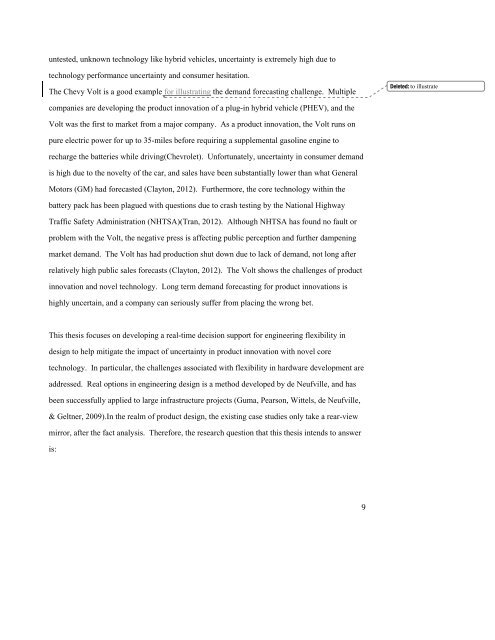A Case Study on Automotive Battery System Design - Title Page - MIT
A Case Study on Automotive Battery System Design - Title Page - MIT
A Case Study on Automotive Battery System Design - Title Page - MIT
- No tags were found...
You also want an ePaper? Increase the reach of your titles
YUMPU automatically turns print PDFs into web optimized ePapers that Google loves.
untested, unknown technology like hybrid vehicles, uncertainty is extremely high due totechnology performance uncertainty and c<strong>on</strong>sumer hesitati<strong>on</strong>.The Chevy Volt is a good example for illustrating the demand forecasting challenge. MultipleDeleted: to illustratecompanies are developing the product innovati<strong>on</strong> of a plug-in hybrid vehicle (PHEV), and theVolt was the first to market from a major company. As a product innovati<strong>on</strong>, the Volt runs <strong>on</strong>pure electric power for up to 35-miles before requiring a supplemental gasoline engine torecharge the batteries while driving(Chevrolet). Unfortunately, uncertainty in c<strong>on</strong>sumer demandis high due to the novelty of the car, and sales have been substantially lower than what GeneralMotors (GM) had forecasted (Clayt<strong>on</strong>, 2012). Furthermore, the core technology within thebattery pack has been plagued with questi<strong>on</strong>s due to crash testing by the Nati<strong>on</strong>al HighwayTraffic Safety Administrati<strong>on</strong> (NHTSA)(Tran, 2012). Although NHTSA has found no fault orproblem with the Volt, the negative press is affecting public percepti<strong>on</strong> and further dampeningmarket demand. The Volt has had producti<strong>on</strong> shut down due to lack of demand, not l<strong>on</strong>g afterrelatively high public sales forecasts (Clayt<strong>on</strong>, 2012). The Volt shows the challenges of productinnovati<strong>on</strong> and novel technology. L<strong>on</strong>g term demand forecasting for product innovati<strong>on</strong>s ishighly uncertain, and a company can seriously suffer from placing the wr<strong>on</strong>g bet.This thesis focuses <strong>on</strong> developing a real-time decisi<strong>on</strong> support for engineering flexibility indesign to help mitigate the impact of uncertainty in product innovati<strong>on</strong> with novel coretechnology. In particular, the challenges associated with flexibility in hardware development areaddressed. Real opti<strong>on</strong>s in engineering design is a method developed by de Neufville, and hasbeen successfully applied to large infrastructure projects (Guma, Pears<strong>on</strong>, Wittels, de Neufville,& Geltner, 2009).In the realm of product design, the existing case studies <strong>on</strong>ly take a rear-viewmirror, after the fact analysis. Therefore, the research questi<strong>on</strong> that this thesis intends to answeris:9
















